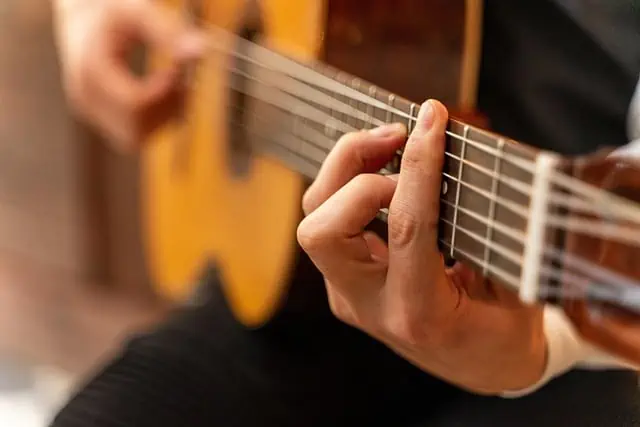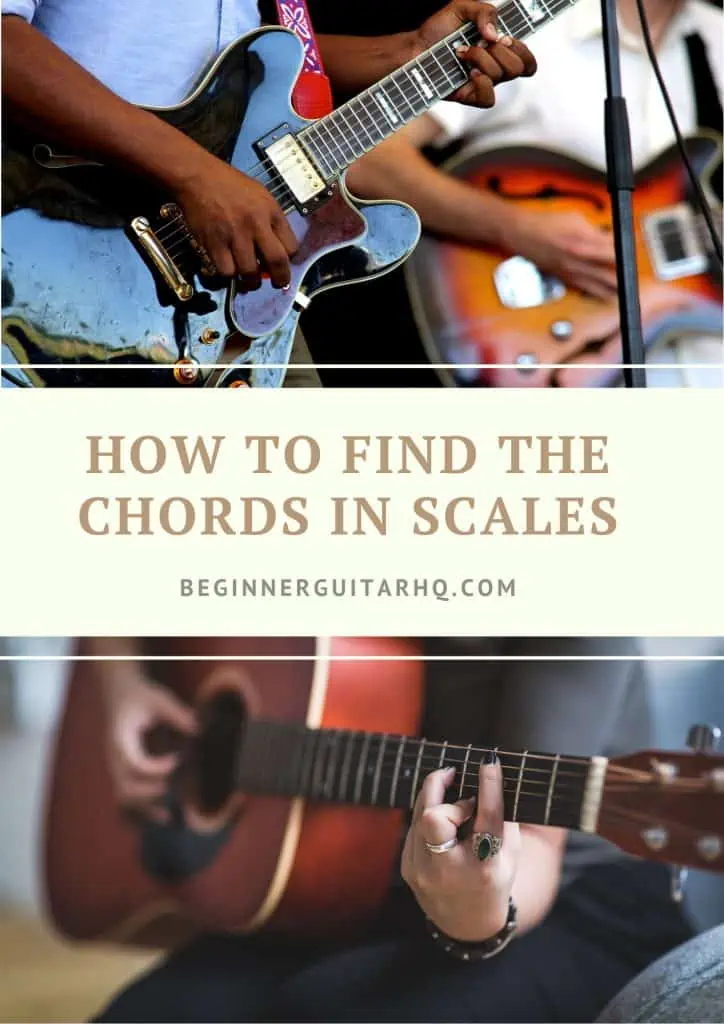If you’ve been learning to play lead or classical guitar, chances are you’ve been introduced to scales. While they can become boring, they really are the basics of music. Now you want to play rhythm guitar and need to know what chords are in the scale. It’s not as simple as just taking all the chords as majors. If you’ve done that, you would have heard it sounds all kinds of wrong. Essentially, you want to find the chords in a key.
It’s not to say that you can’t borrow chords from other keys. But especially if you’re starting out, it’s good to know which chords are in the key so you know exactly which are borrowed and how to use them. Let’s take a look at how to find chords in scales.
The Diatonic Chords in a Scale- a Simple Formula
Diatonic chords simply put, is just the chords or notes that are found in a key. An easy way to always derive the chords from any scale is to use the formula. This formula can be used for basic triads like minor and major chords, as well as 7ths, 9ths, add9’s, etc. You’ll always be able to make your music as complex or as basic as you want with this formula. Major and minor scales have different formulas.
Chord and Interval Representation
The Roman numerals represent major and minor intervals, and for our purposes, chords. The capital letters indicate major intervals/chords and the lower case letters indicate minor intervals/chords. Diminished intervals/chords are represented by a little circle, which is the musical symbol for diminished, next to the Roman numeral. Half diminished chords have circles with a line through them. Augmented chords and intervals have a little plus next to capital Roman numerals. You will see examples of these signs later on.
The Major Scale
I’ll use the key of C since it has no sharps or flats, but this pattern works for every major key. You can easily see the number of sharps or flats in a key by using the circle of fifths:
The C scale consists of the following notes with their intervals written underneath:
C, D, E, F, G, A, B, C
1 2 3 4 5 6 7 8
To completely understand all this, you also need to know about major and minor intervals within the scale. You can see which intervals are minor and major easily when looking at a piano. The black notes represent half notes and the white notes whole notes. The guitar is completely divided into half steps. That’s why you have to skip a fret some intervals and for other notes go to the very next fret.
The Diatonic Chord Pattern of the Major Scale
I ii iii IV V vi vii
Major Minor Minor Major Major Minor Diminished
Let’s take the key of C since it’s the easiest key to see how this translates:
C Dm Em F G Am Bdim
These chords are all triads that are constructed from the 1st, 3rd, and 5th intervals
- Major chords: All three intervals are major (1-3-5)
- Minor chords: Flattened third (1-b3-5)
- Diminished chords: Flattened third and fifth (1-b3-b5)
- Augmented chords: Raised fifth (1-3-#5)
Most of you are familiar with the signs for sharps (♯) and flats (♭), but the signs for the other chords may be a bit foreign:
- Diminished ()
- Half-diminished (ø), you will come across this as you work with chords that go beyond the basic triad structure, written out, it looks a lot more complicated, as you’ll see.
- Augmented (+)
These signs may be written out in word form or you may find chords notated with these symbols.
Back to figuring out the chords in a key:
Because it’s easy to learn scales using a pattern rather than paying attention to each note, I’ve decided to go into more detail. We can see why each chord is major and minor when we look at the major scales of each note within their own key. You’ve already been shown the C major scale, here are the others with their major chord:
- D major scale: D, E, F#, G, A, B, C# (D chord: D-F#-A) (Dm: D-F-A)
- E major scale: E, F#, G#, A, B, C#, D# (E chord: E-G#-B) (Em: E-G-B)
- F major scale: F, G, A, Bb, C, D, E (F chord: F-A-C)
- G major scale: G, A, B, C, D, E, F# (G chord: G-B-D)
- A major scale: A, B, C#, D, E, F#, G# (A chord: A-C#-E) (Am: A-C-E)
- B major scale: B, C#, D#, E, F#, G# A# (B chord: B-D#-F#) (Bdim: B-D-F) (Intervals 1-3b-5b)
Diatonic Seventh Chords in a Major Scale
Seventh chords, as you may have guessed, are constructed by adding on the seventh interval: 1-3-5-7. There are five types of main seventh chords:
- Major seventh chords
- Minor seventh chords
- Dominant seventh chords
- Diminished seventh chords (a.k.a full diminished seventh chords)
- Half-diminished seventh chords
Less commonly, you will also find minor-major seventh chords, particularly in certain types of minor keys. Here are the seventh chords in the C major scale.
Cmaj7, Dm7, Em7, Fmaj7 G7 Am7 Bdim7flat5
Here we see it become a little more complicated. What stands out here is the G dominant 7th and the B diminished 7th flattened 5th aka, B half diminished 7th, Bmin7b5, or Bm7(b5).To see why this is, let’s look at the chord construction bearing in mind the C major scale:
- Cmaj7: C-E-G-B (major chord with a major seventh interval)
- Dm7: D-F-A-C (minor triad with a minor seventh interval)
- Em7: E-B-G-D (minor triad with a minor seventh interval)
- Fmaj7: F-A-C-E (major triad with a major seventh interval)
- G7: G-B-D-F (major triad with a minor seventh interval)
- Am7: A-C-E-B (minor triad with a minor seventh interval)
- Bm7b5 or Bø7: B-D-F-A (half diminished triad with a minor seventh interval)
Diatonic Ninth Chords in a Major Scale
For an even deeper look, let’s check out the 9th chords. These types of chords are popular in jazz. The notes repeat themselves in a scale, just at higher octaves. It can be a bit confusing sometimes, you’ll see ninth intervals referred to as second intervals, but this only applies to single octaves (an octave is 8 notes). If you play it across two octaves, it’s a ninth interval. There are quite a few different types of ninth chords, some of which you’ll only find in minor keys:
- Major ninth chords
- Minor ninth chords
- Dominant ninth chords
- Ninth augmented fifth chords
- Ninth flatted fifth chords
- Seventh flat ninth chords
- Augmented ninth chords
- Ninth diminished fifth chords
- Flatted ninth diminished fifth chords
- Ninth diminished seventh chords
There are more, but for our purposes today, and to keep things a little more simple, we’ll stop the list here.
To construct a ninth chord, we use the intervals 1-3-5-7-9 (or the second interval if you stay in the same octave). You may be thinking how on earth are you going to play a five-note chord with only four fingers, but don’t worry. Just like with seventh chords, you will find guitar chords are structured in a way that in most cases you will only be playing four notes. Guitar chords commonly leave out a note, particularly for more complex chords.
So here we go:
C, D, E, F, G, A, B, C, D, E, F, G, A, B, C
1 2 3 4 5 6 7 8 9 10 11 12 13 14 15
A 9th chord uses these intervals: 1-3-5-7-9
- Cmaj9: C-E-G-B-D (Major triads, major 7th interval, major 9th interval)
- Dm9: D-F-A-C-E (Minor triad, minor 7th interval, major 9th interval)
- Em7b9 or E-7b9: E-B-G-D-F (Minor triad, minor 7th interval, minor 9th interval)
- Fmaj9: F-A-C-E-G (Major triads, major 7th interval, major 9th interval)
- G9: G-B-D-F-A (Major triad, minor 7th interval, major 9th interval)
- Am9: A-C-E-G-B (Minor triad, minor 7th interval, major 9th interval)
- Bm7b5b9 or Bø7b9: B-D-F-A-C (Half-diminished triad, minor 7th interval, minor 9th interval)
The Minor Scale
For our purposes today, I’ll be using the A minor scale, because once again, it has no sharps or flats. In fact, it’s the relative minor of the C major key. Things are a little more complicated when it comes to the minor scale, however, as there are three different types of minor scale.
Here is the natural minor scale in A minor:
A, B, C, D, E, F, G
1 2 3 4 5 6 7
Here is A harmonic minor scale:
The harmonic minor scale has a raised 7th interval.
A, B, C, D, E, F, G#
1 2 3 4 5 6 7
Here is the ascending A melodic minor scale:
The melodic minor scale looks different when ascending and when descending. The melodic minor scale has raised 6th and 7th intervals ascending. Descending, the scale is the same as the natural minor scale. Here is the ascending A melodic scale:
A, B, C, D, E, F#, G#
1 2 3 4 5 6 7
The Diatonic Chord Pattern of the Minor Scale
Because there are three different minor scales, there are more diatonic chords than with the major scale.
Natural Minor Diatonic Pattern:
I ii III iv v VI VII
Minor Diminished Major Minor Minor Major Major
This is how this translates
Am, Bdim, C, Dm, Em, F, G
Harmonic Minor Diatonic Pattern:
i ii III+ iv V VI vii
Minor Diminished Augmented Minor Major Major Diminished
This is how this translates:
Am, Bdim, Caug, Dm, E, F, G#dim
Because of the raised seventh note, in this case, G#, the construction of the chords is different, resulting in the augmented third, major fifth, and diminished seventh.
Ascending Melodic Minor Diatonic Pattern:
I ii III+ IV V vi vii
Minor Minor Augmented Major Major Diminished Diminished
This is how this translates
Am, Bm, Caug, D, E, F#dim, G#dim
Because of the raised sixth and seventh notes, we now have a minor second, major fourth, and a diminished sixth.
Diatonic Seventh Chords in Minor Keys
Because it can get a little confusing, let’s look at the diatonic seventh chords for each minor scale:
Diatonic Seventh Chords in Natural Minor Scales
Am7, Bdim7 flat 5, Cmaj7, Dm7, Em7, Fmaj7, G7
Let’s look at the construction of each of these chords:
- Am7: A, C, E, B (Minor triad, minor seventh interval)
- Bm7b5 or Bø7: B, D, F, A (Half diminished triad, minor seventh interval)
- Cmaj7: C, E, G, B(Major triad, major seventh interval)
- Dm7: D, F, A, C (Minor triad, minor seventh interval)
- Em7: E, B, G, D (Minor triad, minor seventh interval)
- Fmaj7: F, A, C, E (Major triad, major seventh interval)
- G7: G, B, D, A (Major triad, minor seventh interval)
Diatonic Seventh Chords of the Harmonic Minor Scale
Am(maj7), Bdim7flat5, Caug7sharp5, Dm7, E7, Fmaj7, G#dim7
- Am(maj7): A, C, E, G# (Minor triad, major seventh interval)
- Bm7b5 or Bø7: B, D, F, A (Half diminished triad, minor seventh interval)
- Caug7#5 or C+M7 or C+Δ: C, E, G#, B (Augmented triad, major seventh interval)
- Dm7: D, F, A, C (Minor triad, minor seventh interval)
- E7: E, G#, B, D (Major triad, minor seventh interval)
- Fmaj7: F, A, C, E (Major triad, major seventh interval)
- G#dim7 or G#7: G#, B, D, F (Diminished triad, diminished seventh interval)
Diatonic Seventh Chords of the Ascending Melodic Minor Scale
Am(maj7), Bm7, Caug7sharp5, D7, E7, F#dim7flat5, G#dim7flat5
- Am(maj7): A, C, E, G# (Minor triad, major seventh interval)
- Bm7: B, D, F#, C (Minor triad, minor seventh interval)
- Caug7#5 or C+M7 or C+Δ: C, E, G#, B (Augmented triad, major seventh interval)
- D7: D, F#, A, C (Major triad, minor seventh interval)
- E7: E, G#, B, D (Major triad, minor seventh interval)
- F#m7b5 or F#ø7: F#, A, C, E (Half diminished triad, minor seventh interval)
- G#m7b5 or G#ø7: G#, B, D, F# (Half diminished triad, minor seventh interval)
Diatonic Ninth Chords in Minor Keys
Here’s how all this works with the ninth chords using the A minor scale:
Diatonic Ninth Chords in Natural Minor Scales
Here is the natural A minor scale with the interval numbers:
A, B, C, D, E, F, G, A, B, C, D, E, F, G, A
1 2 3 4 5 6 7 8 9 10 11 12 13 14 15
Here are the ninth chords:
Am9 or A-9: A, C, E, G, B (Minor triad, minor seventh interval, major ninth interval)
Bm7b5b9 or Bø7b9: B, D, F, G, A (Half diminished triad, minor 7th interval, minor 9th interval)
Cmaj9 or CM9 or CΔ9: C, E, G, B, D (Major triad, major seventh interval, major ninth interval)
Dm9 or D-9: D, F, A, C, E (Minor triad, minor seventh interval, major ninth interval)
Em7b9 or E-7b9: E, G, B, D, F (Minor triad, minor seventh interval, minor ninth interval)
Fmaj9 or FM9 or FΔ9: F, A, C, E, G (Major triad, major seventh interval, major ninth interval)
G9 or G7/9 or Gdom9: G, B, D, F, A (Major triad, minor seventh interval, major ninth interval)
Diatonic Ninth Chords in Harmonic Minor Scales
Here are the notes of the A harmonic minor scale with the intervals:
A, B, C, D, E, F, G#, A, B, C, D, E, F, G#, A
1 2 3 4 5 6 7 8 9 10 11 12 13 14 15
i ii III+ iv V VI vii
Minor Diminished Augmented Minor Major Major Diminished
Am(maj9) or A–M9: A, C, E, G#, B (Minor triad, major seventh interval, major ninth interval)
Bm7b5b9 or Bø7b9: B, D, F, G, A (Half diminished triad, minor 7th interval, minor 9th interval)
Caug(maj9) or C+maj9: C, E, G# B, D (Augmented triad, major seventh interval, major ninth interval)
Dm9 or D-9: D, F, A, C, E (Minor triad, minor seventh interval, major ninth interval)
Edom(b9) E7b9: E, G#, B, D, F (Major triad, minor seventh interval, minor ninth interval)
Fmaj7#9 or FM7#9 or FΔ7#9: F, A, C, E, G# (Major triad, major seventh interval, augmented ninth interval)
G#dim(b9) or G#b9: G#, B, D, F, A (Diminished triad, diminished seventh interval, minor ninth interval)
For reference on the G#b9, let’s look at the G# scale
G#, A#, B, C#, D#, E, F#, G#, A#, B, C#, D#, E, F#
1 2 3 4 5 6 7 8 9 10 11 12 13 14
Diatonic Ninth Chords in Ascending Melodic Minor Scales
Here are the chords for the A minor ascending melodic minor scale. Remember the F has become an F sharp:
A, B, C, D, E, F#, G#, A, B, C, D, E, F#, G#, A
1 2 3 4 5 6 7 8 9 10 11 12 13 14 15
A reminder of the interval types of the ascending melodic minor scale:
I ii III+ IV V vi vii
Minor Minor Augmented Major Major Diminished Diminished
Am(maj9) or A–M9: A, C, E, G#, B (Minor triad, major seventh interval, major ninth interval)
Bm7b9 or B-7b9: B, D, F#, A, C (Minor triad, minor seventh interval, minor ninth interval)
Caug(maj9) or C+maj9: C, E, G# B, D (Augmented triad, major seventh interval, major ninth interval)
D9 or D7/9 or Ddom9: D, F#, A, C, E (Major triad, minor seventh interval, major ninth interval)
E9 or E7/9 or Edom9: E, G#, B, D, F# (Major triad, minor seventh interval, major ninth interval)
F#m9b5 or F#ø9: F#, A, C, E, G# (diminished triad, minor seventh interval, minor ninth interval)
G#m9b5 or G#ø9: G#, B, D, F#, A (diminished triad, minor seventh interval, minor ninth interval)
For reference, here is the F# major scale:
F#, G#, A#, B, C#, D#, E# (and yes, technically E# is F).
Conclusion
There you have it. Any types of chords you build will follow the same patterns in any key. You can do this will sixths, elevenths, thirteenths, etc. While it will be good in terms of music theory to learn your intervals as this will help you to construct chords, you can also just learn the type of chords in the scale.
Some of these chords can be challenging to play, but pick the simpler versions if need be, and practice can help your fingers with muscle memory. These range of chords, even the rare ones, will help you explore your creative side. Don’t be afraid to experiment. If you like the way it sounds, go for it!
Happy jamming!

Cheanné Lombard lives in the home of one of the new Seven World Wonders, Cape Town, South Africa. She can’t go a day without listening to or making music.
Her love of music started when her grandparents gave her a guitar. It was a smaller version of the full-sized guitars fit for her little hands. Later came a keyboard and a few years after that, a beautiful dreadnought guitar and a violin too. While she is self-taught when it comes to the guitar, she had piano lessons as a child and is now taking violin lessons as an adult.
She has been playing guitar for over 15 years and enjoys a good jam session with her husband, also an avid guitarist. In fact, the way he played those jazzy, bluesy numbers that kindled the fire in her punk rock heart. Now she explores a variety of genres and plays in the church worship group too and with whoever else is up for a jam session.





